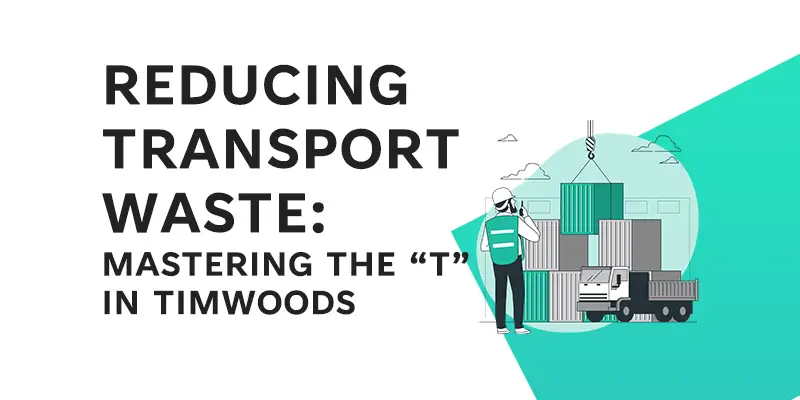Imagine you’re in a bustling factory filled with activity. Products are assembled, quality checks are done, and items are shipped out. But, in the midst of this, you notice something — forklifts zigzagging across the floor, moving parts from one corner to another, often covering more distance than needed. This is not just a logistical puzzle; it’s a sign of “Transport” waste, the often-underestimated ‘T’ in the TIMWOODS framework of Lean Six Sigma.
Understanding and optimizing this ‘T’ is pivotal in achieving operational excellence. The TIMWOODS acronym stands for eight types of waste: Transport, Inventory, Motion, Waiting, Overprocessing, Overproduction, Defects, and Skills. Each is crucial, but Transport often gets sidelined in discussions about efficiency. In this blog post, we’ll zero in on Transport waste, delving into its identification, strategies for its reduction, and measuring its impact on overall efficiency. Prepare to master the ‘T’ and propel your business operations to a new level of efficiency.
Table of Contents
Understanding the ‘T’ in TIMWOODS
Definition of Transport Waste
Transport waste, often referred to simply as ‘Transport,’ is any unnecessary movement of materials, products, or information that doesn’t add value to the end product or service. In Lean Six Sigma, value is defined from the customer’s perspective—anything that the customer is willing to pay for. If moving an item from point A to point B doesn’t directly contribute to what the customer values, it’s considered transport waste. It’s essential to differentiate between ‘necessary’ and ‘unnecessary’ movement; not all transport can or should be eliminated, but it can often be optimized.

Common Examples in Various Industries
- Manufacturing: Excessive movement of raw materials from storage to production lines, or finished goods from the production line to the warehouse.
- Automotive: Transporting car parts over long distances between different manufacturing plants.
- FMCG (Fast-Moving Consumer Goods): Movement of goods from central warehouses to retail outlets, particularly if they are moved multiple times before reaching the end consumer.
- Public Sector: Shuffling of paperwork between departments or locations, which could have been done digitally.
- Logistics: Inefficient routing of delivery trucks leading to extra miles covered.
- Warehousing: Unnecessary movement of items within the warehouse due to poor layout or lack of a well-defined storage system.
- Consulting for Businesses: Sharing of bulky project files between teams or locations, which could be streamlined with digital solutions.
The Impact on Overall Efficiency
- Increased Costs: Fuel, labor, and time—all these resources are spent more when transport is inefficient. These increased operational costs can impact your bottom line.
- Delays: Excessive transport can result in delays that ripple through the entire production cycle, leading to longer lead times and dissatisfied customers.
- Increased Risk: More movement means more chances for damage, loss, or theft of goods and materials.
- Environmental Impact: Inefficient transport practices often lead to higher emissions, which is detrimental to the environment.
- Resource Drain: Employees engaged in unnecessary transport could be better utilized in value-adding activities, thus increasing productivity.
Graphical Elements:
- Infographic: A flowchart that starts with a product/material and traces its path, highlighting points where transport waste commonly occurs.
By understanding the definition, recognizing common examples, and grasping the impact on overall efficiency, you can begin to identify transport waste in your operations and take steps to eliminate or reduce it.
Identifying Transport Waste
Signs of Inefficient Transport
- Multiple Handoffs: If materials or information are passed through several points or personnel before reaching their final destination, this often signifies inefficient transport.
- Long Wait Times: Extended periods of inactivity for materials or goods usually indicate they have been transported to a location prematurely.
- High Inventory Levels: Excess inventory is often a symptom of inefficient transportation systems that require large stockpiles to accommodate for the inefficiency.
- Frequent Transport Equipment Repairs: Breakdowns and frequent maintenance can indicate that the transport methods being used are inefficient or sub-optimal.
- Complicated Routing: If the journey from Point A to Point B involves several detours, unnecessary steps, or backtracking, you’re likely encountering transport waste.
Tools and Metrics for Identification
Value Stream Mapping
Value Stream Mapping is a graphical tool that helps you visualize all the steps and processes involved in moving a product or service through the value stream. This tool can reveal bottlenecks, delays, and inefficiencies, including transport waste.
- Map out the current state of your value stream, identifying all steps, inventories, and transport routes.
- Look for areas where transport does not add value and focus on ways to streamline these areas.
Transport Efficiency Ratios
Key Performance Indicators (KPIs) like ‘Miles per Delivery,’ ‘Cost per Mile,’ or ‘Items Moved per Man-Hour’ are vital metrics for gauging transport efficiency. Monitoring these ratios can provide insights into where waste is occurring.
- Establish baseline metrics for your operation.
- Use data to monitor the efficiency ratios over time and identify variations that may signal waste.
Graphical Elements:
- Value Stream Map: A before-and-after visualization of a process flow to highlight areas of transport waste reduction.
Identifying transport waste is the crucial first step toward eliminating it. With these tools and insights, you’ll be well-equipped to do just that.
Strategies to Reduce Transport Waste
Lean Techniques
Just-in-Time Delivery
What It Is: Just-in-Time (JIT) Delivery is a strategy that aims to improve a business’s return on investment by reducing in-process inventory and associated carrying costs. The goal is to receive materials or products exactly when they are needed in the production process.
- Partner with suppliers to synchronize deliveries to meet production schedules.
- Use real-time inventory tracking systems to ensure that only the necessary quantities are ordered and stocked.
Kanban
What It Is: Kanban is a visual tool that helps manage workflow and optimize efficiency. It’s a method for regulating the flow of goods (both within the factory and with outside suppliers and customers) based on actual demand.
- Establish Kanban cards at different points in the production process.
- Use these cards as visual cues for when to move, produce, or order more materials.
Training
What It Is: Educating team members about the importance of minimizing transport waste and providing them with tools to identify and mitigate it.
- Regular workshops focusing on Lean principles and specific case studies related to transport.
- On-the-job training to help workers identify and eliminate instances of transport waste.
Team Communication
What It Is: Effective communication among team members ensures that everyone understands their role in reducing transport waste.
- Implement tools like digital dashboards or communication platforms that allow real-time updates and collaborative planning.
- Encourage open dialogue and suggestion systems to engage workers in the continuous improvement process.
By adopting these various strategies, businesses can substantially reduce transport waste, improving both their bottom line and their environmental footprint.
Measuring Success
KPIs for Transport Efficiency
Key Performance Indicators (KPIs) are essential metrics that help you gauge the efficiency of your transport operations. Some common KPIs include:
- Cost per Mile: Measures the cost incurred for each mile a vehicle travels.
- Load Utilization: Percentage of the total available cargo space that is utilized.
- On-time Deliveries: Measures the percentage of deliveries made within the stipulated timeframe.
- Fuel Efficiency: The average distance covered per unit of fuel.
Continuous Monitoring and Adjustment
In a landscape that’s continuously evolving, merely implementing strategies isn’t enough. It’s crucial to:
- Monitor: Use the identified KPIs to track performance regularly.
- Analyze: Use analytics tools to understand the data deeply.
- Adjust: Make data-driven adjustments to your strategies as needed.
Celebrating Success Stories and Learnings
- Case Studies: Regularly document and share internal success stories where transport waste was identified and eliminated.
- Learnings: Discuss and share lessons learned from failed attempts to encourage a culture of continuous improvement.
Challenges and Pitfalls
Common Mistakes
- Ignoring the Human Element: Transport efficiency isn’t just about machines and software; people play a huge role. Ignoring training or communication can result in failed implementations.
- Failure to Adapt: A one-size-fits-all approach seldom works. What worked in another scenario may not work for you.
- Overlooking Maintenance: Cutting corners in maintenance can lead to frequent breakdowns, nullifying any efficiency gains.
How to Overcome These Challenges
- Customization: Always tailor your strategies to fit the unique needs and circumstances of your operation.
- Comprehensive Training: Ensure that the workforce is educated and onboard with the changes being implemented.
- Regular Audits: Implement a routine check or audit to ensure that all equipment and systems are in optimal condition.
Conclusion
Reducing waste in transport—the ‘T’ in TIMWOODS—is not just about cutting costs; it’s about elevating the entire operational ecosystem to a new level of efficiency and sustainability. From understanding what transport waste entails to implementing targeted strategies like Lean
Techniques and Technology Solutions, organizations have a plethora of options at their disposal. However, the journey doesn’t end with the implementation of these strategies. Continuous monitoring through KPIs and an openness to adjust and evolve are integral to sustained success. Equally important is being cognizant of the pitfalls that could derail your efforts, and proactively setting up mechanisms to overcome them. The road to a waste-free transport system is a long one, but with the right tools, strategies, and mindset, it is entirely within reach. Make your move towards a leaner, more efficient future today.
References
- Taylor, L., Martichenko, R. and LeanCor, L.L.C., 2006. Lean transportation-fact or fiction?. Executive White Paper, www. fedex. com.








